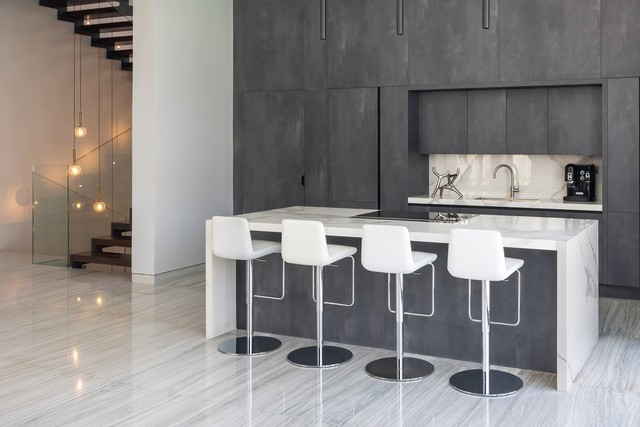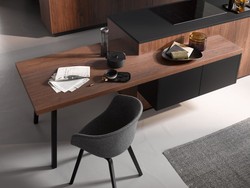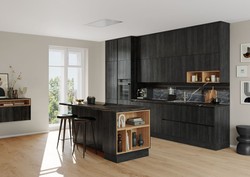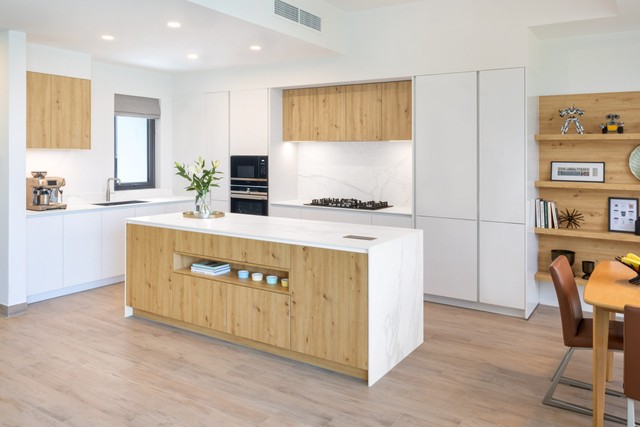In the realm of kitchen design, one element stands out as a true powerhouse of versatility—the kitchen island. Far beyond being a mere countertop extension, the kitchen island has evolved into a multifunctional hub that caters to a myriad of culinary needs. Senior Designer Julia Eissing shares expert insights on the transformative potential of the kitchen island and how it can turn the heart of the home into a dynamic space that seamlessly combines functionality with style.
A Central Hub for Cooking
At its core, the kitchen island serves as a central hub for cooking, offering a spacious and centralised work area that enhances efficiency in meal preparation. Its adaptability allows homeowners to tailor the island’s design to meet their specific needs. For instance, it can house a sleek sink and a state-of-the-art hob, creating a designated space for both food preparation and cleanup. This dual functionality not only streamlines the cooking process but also facilitates a more organised and enjoyable culinary experience.
Seating Variations for Social Interaction
One of the standout features of a versatile kitchen island is its ability to accommodate various seating arrangements, transforming it into a social hub within the home. Homeowners can opt for a seamlessly integrated table attached to the island, providing a cosy spot for family meals or casual gatherings. Alternatively, high-level seating options, such as bar stools or counter-height chairs, can be incorporated, turning the kitchen into a welcoming space for friends to gather while the chef works their magic.
Aesthetics Meets Functionality
Beyond its practical applications, the kitchen island serves as a canvas for merging aesthetics with functionality. The choice of materials, colours, and design elements can be tailored to complement the kitchen design. Whether it’s a sleek, modern island with clean lines or a rustic, farmhouse-inspired centrepiece, the versatility of the kitchen island allows homeowners to express their unique style while maintaining practicality.
Storage Solutions and Organisation
Another feather in the cap of the kitchen island is its potential to address storage challenges. Cleverly designed islands can incorporate ample storage space, featuring drawers, shelves, and cabinets that keep kitchen essentials within arm’s reach. This not only enhances the island’s functionality but also contributes to an organized and clutter-free kitchen environment.
Entertaining Made Effortless
The adaptability of the kitchen island extends beyond daily meal preparation, making it an invaluable asset when entertaining guests. Its central location encourages social interaction, allowing hosts to engage with guests while effortlessly preparing meals. The incorporation of additional features like built-in wine fridges, refrigerated drawers, or even a second sink can elevate the island’s functionality, ensuring a seamless transition from everyday use to entertaining.
Professional and Relaxation Fusion
For those who embrace a work-from-home lifestyle, the kitchen island can double as a flexible workspace. Its expansive surface provides an ideal area for spreading out laptops, papers, and projects, blurring the lines between the kitchen and home office. This versatility allows individuals to seamlessly transition between professional tasks and leisure, fostering a dynamic living environment.
The kitchen island has transcended its traditional role to become a symbol of versatility and adaptability in today’s kitchen design. Its ability to accommodate various functions, from meal preparation to socialising and even remote work, underscores its importance as a dynamic centrepiece in homes. As homeowners continue to seek innovative solutions that enhance both form and function, the kitchen island stands tall as a testament to the ever-evolving landscape of culinary creativity and domestic living.








